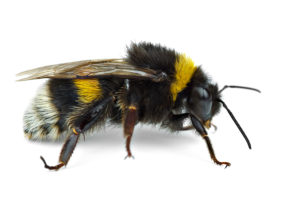 INTRODUCTION: The common name of bumble bee possibly comes from their rather large, clumsy appearance and/or the buzzing sound they make as they fly. In the urban setting, bumble bees do not usually nest in structures but are of concern because of their abundance around the many flowering plants typical of yards, and because they can sting.
INTRODUCTION: The common name of bumble bee possibly comes from their rather large, clumsy appearance and/or the buzzing sound they make as they fly. In the urban setting, bumble bees do not usually nest in structures but are of concern because of their abundance around the many flowering plants typical of yards, and because they can sting.
RECOGNITION: Adult worker body length about 1/4-1″ (6-25 mm), queens about 3/4-1″ (17-25 mm) long; robust in form. Color black with yellow markings; with overall fuzzy appearance, including top surface of abdomen.
BIOLOGY: Bumble bees are social insects which live in nests or colonies. The adults are represented by workers which are sterile females, queens, and males which come from unfertilized eggs and usually appear in late summer.
Typically, only inseminated queens overwinter and do so underground. In the spring, the queens of Psithyrus species wait until the Bombus nests are moderate in size and then parasitize them. The Bombus queens select a suitable subterranean cavity or surface grass clump as a nesting site. Then the Bombus queen fashions a honey pot of wax scales near the nest entrance into which she regurgitates nectar. Next she makes a pollen clump on the nest floor and lays 8-10 eggs on it. The queen will periodically add pollen and nectar to the peripheral edges of the clump, and eventually more eggs.
In the late summer only males (drones) and new queens are reared in the nest. Once these new queens emerge, they mate and find a suitable place to overwinter. The males, workers, old queen, and any virgin new queens die with the onset of cold weather.
Defense is usually done by using their relatively smooth stingers which can be used over and over. Some species will also spray feces, and some cover the intruder with regurgitated honey. People sensitive to insect venom should exercise care around bumble bee nests.
CONTROL: Bumble bees are considered beneficial insects because they pollinate the flowers of many plant species. However, if their nest is located in or close to an occupied structure or recreational area, then control is warranted. During the day find the location of each nest by observing where the bees disappear into the ground, grass clump, or structure.
